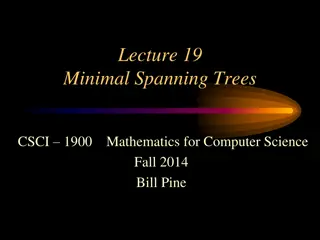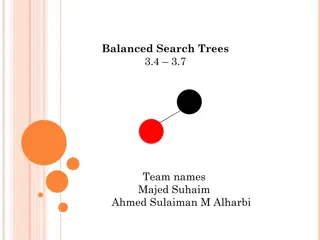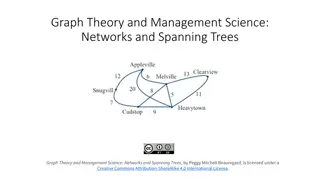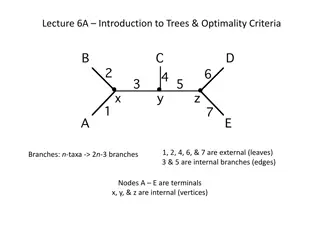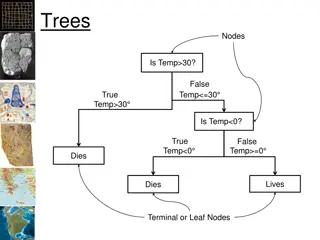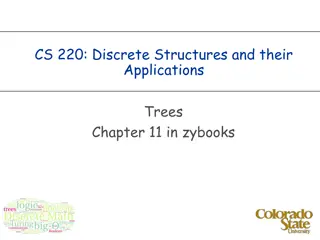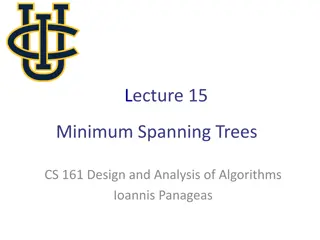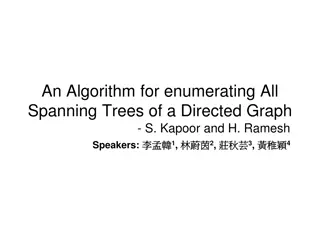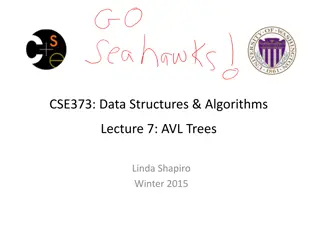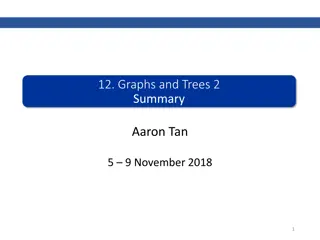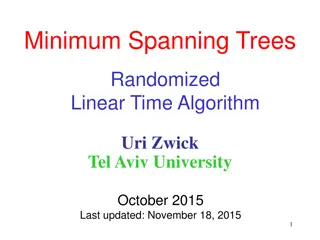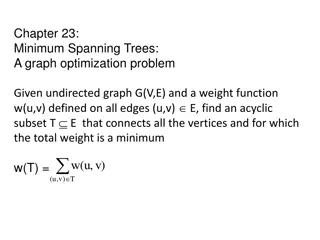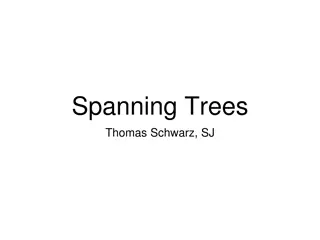
Minimum Spanning Trees and Prim's Algorithm
Explore the concept of Minimum Spanning Trees (MST) in graph theory, their applications, how to determine MST using Prim's Algorithm, and efficient implementation methods. Learn about the significance of MST in solving various optimization problems like the Travelling Salesman Problem and network design.
Download Presentation

Please find below an Image/Link to download the presentation.
The content on the website is provided AS IS for your information and personal use only. It may not be sold, licensed, or shared on other websites without obtaining consent from the author. If you encounter any issues during the download, it is possible that the publisher has removed the file from their server.
You are allowed to download the files provided on this website for personal or commercial use, subject to the condition that they are used lawfully. All files are the property of their respective owners.
The content on the website is provided AS IS for your information and personal use only. It may not be sold, licensed, or shared on other websites without obtaining consent from the author.
E N D
Presentation Transcript
MINIMUM SPANNING TREES Tian Cilliers | Training Camp 3 | 9-10 March 2019
DEFINITION A minimum spanning tree (MST) is a subset of the edges of a connected, edge- weighted undirected graph that connects all the vertices together, without any cycles and with the minimum possible total edge weight.
APPLICATIONS Approximating Travelling Salesman Problem, Perfect Matching, Single- Terminal Maximum Flow Communications network design, electricity grid or transportation system optimization Cluster analysis Taxonomy A lot of other weird stuff I don t understand
SAMPLE PROBLEM Given some weighted, undirected graph. Determine the minimum sum of edge weights necessary to connect all nodes.
POSSIBLE SOLUTION Generate all possible spanning trees (connecting all nodes), calculate the sum of their edge weights, and choose their minimum.
PROBLEMS WITH SOLUTION Obviously, this solution runs in ?(??? ????). Is there a faster, greedy way to determine the MST?
ALGORITHM Start with a single vertex from the graph. While all vertices has not been processed, do the following: Retrieve the edge with the smallest weight connecting an unprocessed vertex to the graph. Connect the vertex to the graph with the edge. Process all other edges connected to the added vertex for use later.
IMPLEMENTATION Keep a priority queue of the vertices considered, sorted by the weight of the edge connecting them. Keep a visited array to check if a particular node has been visited yet. The rest of the algorithm follows logically from here. The total runtime is ?(?log?) as well, since all edges are processed, and the efficiency of a priority queue is logarithmic.
ALGORITHM Start with a separate tree for each vertex, consisting only of that vertex. While all edges has not been processed and the graph is not spanning, do the following: Retrieve the unprocessed edge with the lowest weight. If it connects two unconnected trees in the graph, add it to the graph and join the trees.
IMPLEMENTATION Finding minimum unprocessed edge can be done by sorting edges at the start. Finding if an edge connects two trees can be done using the Disjoint-Set data structure. The rest of the implementation is trivial and is left as an exercise to the reader. The total time complexity is ?(?log?) since it is limited by the time required to sort the array.
TRAIL MAINTENANCE (PROBLEM) Cows want to maintain certain trails between fields. The total length of trails maintained must be minimized. They start off with no trails, and after each week they discover a new path. Given the trails they discover each week, you need to determine the total distance of the trails after each week.
TRAIL MAINTENANCE (SOLUTION) Recalculate the MST after each week using all previous paths (50%) Do the same, but only look at the best path between two fields (60%) Do the same, but only look at the previous MST and the new path (100%)




